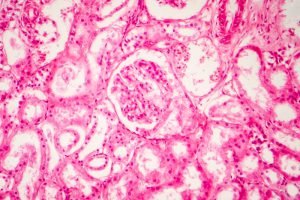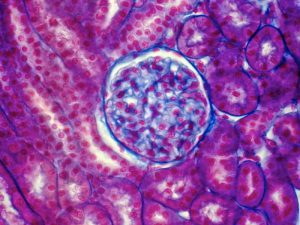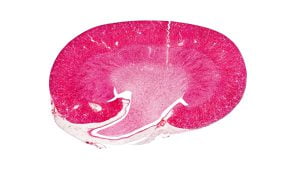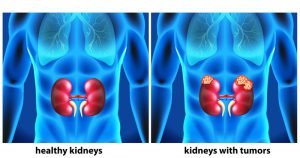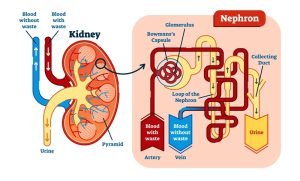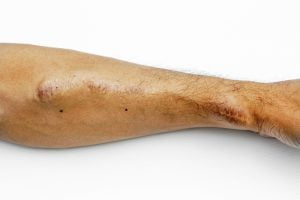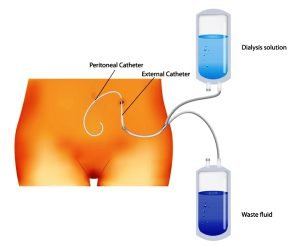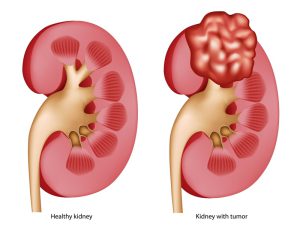Browsing: Kidney Cancer Graphics
Comprehensive Information, Resources, and Support on Kidney Cancer
Kidney has granular cortex and it is full of ovoid filtration units. The secretory units or cells of the kidney, called renal corpuscles comprise a relatively small proportion of the kidney. Major portion of the kidney consists of highly specialized tubules. The renal corpuscle and its associated tubule, together, are called a nephron. In a kidney, each corpuscle secretes a filtrate of blood plasma which drains into its associated renal tubule and the renal tubules modify the filtrate by reabsorbing everything that is not waste. Kidney cancer is a major problem which develops in kidney cells. It might be due to infected blood reached the kidneys, but no exact cause is known. Genetics play an important role.
Kidneys are bean-shaped organs in the renal system which helps the body to pass waste in the form of urine. Main function of kidney is to maintain overall fluid balance, regulating and filtering minerals from blood before sending it back to the heart, filtering waste materials from food, medications, and toxic substances, creating hormones that help produce red blood cells, promote bone health, and regulate blood pressure. Severe problems associated with kidney are kidney failure, kidney stone, nephritis, kidney cancer, etc. Kidney cancer, also called renal cancer, leads to mutations in the DNA of kidney cells. These abnormal cells form tumors which can spread beyond the kidney to different parts of the body.
The image shows an illustration of kidneys in a healthy person vs in a cancer patient. Kidney cancer, also called renal cancer, is a disease in which kidney cells become malignant (cancerous) and grow out of control, forming a tumor. These cancerous cells invade and destroy normal kidney tissues, and can spread to other organs. Even if someone has kidney cancer, his/her kidneys may still function normally.
Nephron is the functional unit of kidney. It produces urine in the process of waste removal from the blood. Each human kidney has about 1,000,000 nephrons. The length of each nephron in the mammalian kidney is about 30–55 mm (1.2–2.2 inches) like a long tubule, or extremely fine tube. The anatomic sections of the nephron comprise of two major portions such as renal corpuscle (Malpighian body), renal tubule. A renal corpuscle comprises of a glomerulus surrounded by a glomerular capsule (Bowman’s capsule) whereas renal tubule extends from Bowman’s capsule and comprises of proximal tubule, loop of henle, distal tubule and collecting duct. For chronic kidney disease, the main reason could be damage to the nephrons. Kidney cancer can also occur due to severe damage.
An arteriovenous (AV) fistula is best for long term arm hemodialysis. AV fistula is a vascular access used to administer the blood for hemodialysis treatment. During arm hemodialysis, an artery is connected to a vein, in arm, to create an AV fistula. When an artery is connected to a vein, the vein grows wider and thicker, which makes it easy to place the needles for dialysis. The goal of arm hemodialysis through AV fistula is to allow high blood flow so that the largest amount of blood can pass through the dialyzer. Patients on long-term kidney dialysis have an elevated risk of developing kidney cysts which increases the risk of kidney cancer.
Kidney cancer is a cancer that starts in the cells of the kidney. About 9 out of 10 kidney cancers are renal cell carcinoma (RCC), sometimes also called renal adenocarcinoma.
The outer region of the kidney contains about millions of nephrons which are the filtration units in kidneys. Nephrons include glomerulus which is a cluster of blood capillaries surrounded by a Bowman’s capsule. These glomerular capillaries help to filter the blood depending upon particle size. Blood flows through arterioles. The fluid is filtered out through the inner wall of the capsule and into the nephron tubule. The final product is urine, which is conveyed through the collecting tubules into the renal pelvis. If urination is not proper, it indicates abnormality. It is observed that almost all kidney cancers initially appear in the lining of tubules in the kidney.
Peritoneal dialysis is a treatment method used to clean the blood manually after kidneys failure. Peritoneal dialysis uses the lining of abdomen, or belly, to filter the blood inside the body. This lining is known as the peritoneum. Before perithoneal dialysis, a soft tube, called a catheter, is placed in the belly. In the beginning, a dialysis solution (water with salt and other additives) is passed into the belly through a catheter from a bag. While the dialysis solution is inside the belly, it absorbs wastes and extra fluid from the body. After sometime, this solution and the wastes are drained out of the belly into the empty bag and thrown. Peritoneal dialysis make feel better temporarily but is not a cure for any kidney disease such as kidney cancer, kidney failure, etc.
Kidney cancer (also called renal cancer) is a cancer that begins in the kidneys. Cancer starts when cells in the body begin to grow out of control. Cells in nearly any part of the body can become cancer, and can spread to other areas. Kidney cancer symptoms are difficult to detect in the beginning but they do exist. It is one of the top 10 most common cancers diagnosed in the United States. About 15,000 people die from this disease each year.
ADVERTISEMENT




